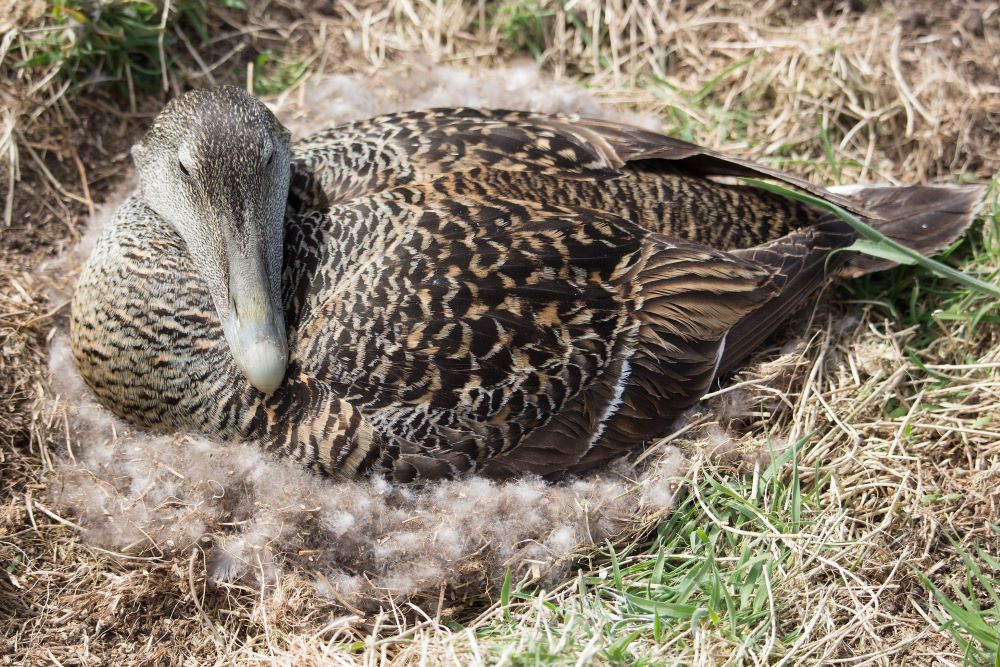
Ground-nesting waterbirds such as ducks have been declining across Denmark and Finland in recent decades, with breeding pair numbers falling since the 1980s. Predators of duck eggs have become more abundant during this time, including invasive species such as American mink, raccoons and raccoon dogs.
Invasive predators
Invasive predators are generally thought to have a greater effect on prey than their native counterparts, although there is little research to demonstrate this for ground-nesting ducks. Now, a new study has shown that one invasive species may be taking the lion’s share of duck eggs over all other nest predators in Finland and Denmark: the raccoon dog.
Similar in appearance to raccoons but larger, raccoon dogs are one of many predators with a taste for duck eggs in Scandinavia. Previous research has shown that invasive American mink can predate on duck nests, as well as native red foxes, badgers, pine martens and stone martens.
Egg eaters
To find out which species were the most prolific egg eaters, the research team constructed artificial nests in forests, wetlands and lake shorelines across Finland and Denmark during the duck breeding season. Each nest was constructed from duck eider down and natural materials from the nest surroundings and contained farmed duck eggs. Motion-sensing cameras positioned near the nests recorded footage of any visitors for one week.
Eggs were taken from 63 out of a total of over 400 artificial nests over the course of the week. Raccoon dogs were the most common predator across all habitats, followed by the red fox, which was common in lake shoreline and wetland habitats. Pine and stone martens were also effective predators, responsible for 19% of all egg predation. Rarer predators included a Eurasian lynx and an ambitious hedgehog, which managed to remove some eggs from a nest but did not break any of them.
Raccoon dogs – broad diet
The ubiquitous prevalence of raccoon dogs across the nest sites can be explained by its smaller range size, which allows for denser populations than other predators, and its broad diet, which means it can feed across many different habitats.

The authors of the study acknowledged that the use of artificial nests and farmed eggs rather than real nests could alter predatory behaviour, as certain predators may have a predilection for the eggs of particular duck species, or may not recognise the artificial nest as a potential food source. However, a previous study showed that the species abundances of predators visiting artificial and real dusky Canada geese nests were similar, suggesting that artificial nest construction has little effect on predatory behaviour.
Decline in ground-nesting ducks
Whilst this study indicates that raccoon dogs are driving the decline in ground-nesting ducks, other contributing factors may exist. Eutrophication appears to be affecting duck populations, as breeding pairs nesting near eutrophic lakes have disappeared at an alarming rate in recent years. Diminishing colonies of gulls such as the black-headed gull, which protect ground-nesting waterbirds by mobbing and attacking predators, may also be contributing to the loss of ground-nesting ducks.
Raccoon dogs eradication
Nevertheless, raccoon dogs are clearly dispersing widely across Europe, a trend that is likely to continue unless control measures are introduced. A successful eradication program has already been established in Sweden, and the study authors advocate for trials of similar control measures in Finland and Denmark, to test whether the removal of raccoon dogs from an ecosystem allows ground-nesting duck populations to recover.
Further reading
Reference: Holopainen S, Väänänen VM, Vehkaoja M & Fox AD (2021) Do alien predators pose a particular risk to duck nests in Northern Europe? Results from an artificial nest experiment. Biological Invasions. https://doi.org/10.1007/s10530-021-02608-2
Raccoon dog, Invasive Species Compendium: https://www.cabi.org/isc/datasheet/72656
